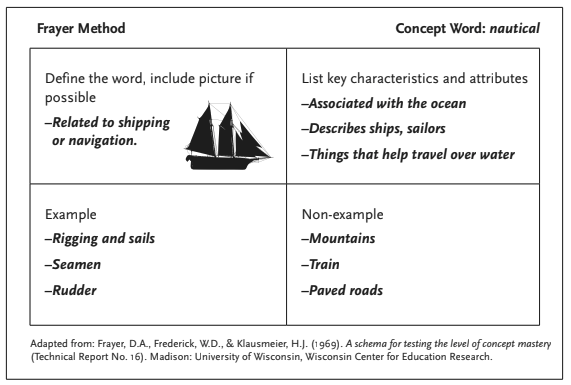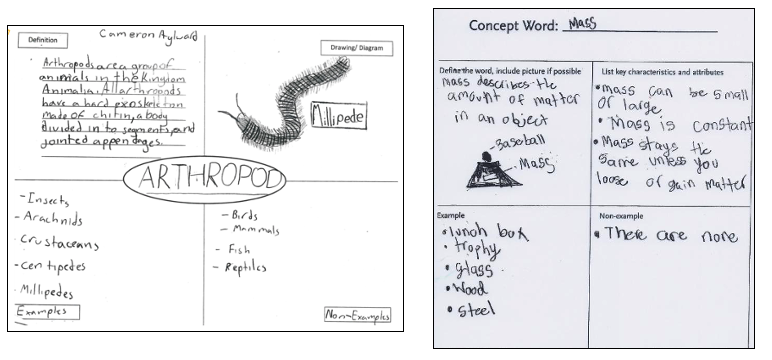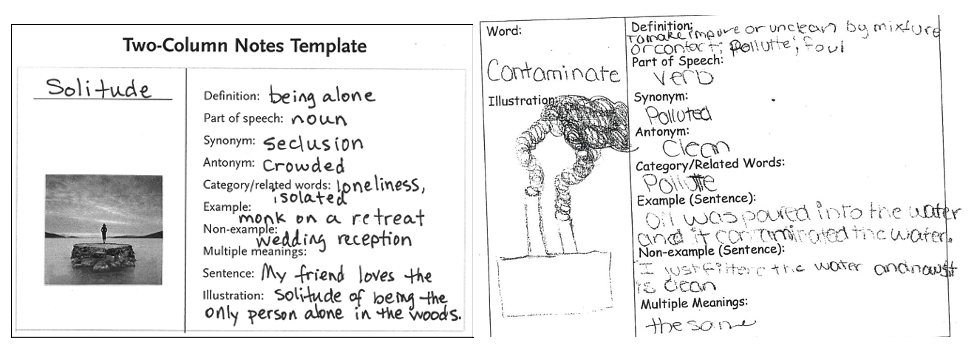Vocabulary: Templates for Teaching Words In-Depth

This post features two scaffolds that can be used to teach specific words: the Frayer and the Two-Column templates. Effective vocabulary instruction should combine direct and indirect approaches to developing students’ vocabularies. Direct methods of vocabulary instruction include teaching strategies for learning new words such as analyzing word parts and using the context to determine the meaning of unfamiliar words. It also includes providing in-depth instruction for specific words. Research has shown that direct instruction of at least 400 words per year produces gains in vocabulary and comprehension (Beck et al., 2002; Biemiller, 2004). The Common Core State Standards (and similar state-specific standards) call for students to “acquire and use accurately a range of general academic and domain-specific words and phrases” (Language anchor standard #6).
What words should be taught in-depth? The answer varies depending on the subject area, grade level, and needs of your students, but in general, teachers should target academic vocabulary likely to appear in multiple subjects, and essential subject-specific words. Beck, McKeown, and Kucan offer suggestions for how to select words to teach (see their Choosing Words to Teach article in Reading Rockets) and the Common Core offers helpful suggestions in Appendix A: Research Supporting Key Elements of the Standards in the vocabulary section (see pages 32-35).
Once a word has been identified to teach in-depth, it is important to teach everything about that word! Knowledge of a word means knowing much more than its definition. Essential information about a word includes its spelling and pronunciation, its part of speech, synonyms and antonyms, a visual that might represent the meaning, other words that are related, and use of the word in context (e.g., within a sentence). It is also helpful for students to know if a word has multiple meanings.
There are two templates that can be used to gather multiple types of information about a word: Frayer and Two-Column. You can download blank copies of these templates by clicking here for the Frayer and here for the Two-Column. These templates are included in Chapter 5: Select Specific Words to Teach In-Depth of The Key Vocabulary Routine.
The Frayer Method (Frayer, et al., 1969) encourages students to analyze a word’s key attributes and include “examples” and “non-examples” of the concept represented by the word. The graphic below shows an example of a completed Frayer template for the word nautical.

The second template is the Two-Column (Sedita, 2003, 2010). A word is listed in the left column, and information about the word is added in the right column (definition, synonyms and antonyms, related words, examples and non-examples, multiple meanings, and use in a sample sentence). A visual can be added to the left or right column. The graphic below shows an example of a completed Two-Column for the same word.

Who completes these templates, the teacher or the student? The answer is both! The teacher might model how to complete these templates during a whole group lesson by filling in some or all of the template. Students can work collaboratively in pairs or small groups to discuss the word and complete the templates together. Students can also work independently to complete a template and then share their work with peers or the teacher. Copies of these templates can be saved to use for vocabulary review.
Below, you can view multiple classroom examples that span multiple grades and subjects. Use these examples as a springboard for ideas to use these templates with your students!




References:
- Beck, I. L. & McKeown, M.G., & Kucan, L. Choosing words to teach. Reading Rockets. Retrieved from https://www.readingrockets.org/article/choosing-words-teach
- Beck, I. L. & McKeown, M.G., & Kucan, L. (2002). Bringing words to life. New York: Guilford Press.
- Biemiller, A. (2004). Teaching vocabulary in the primary grades. In James F. Baumann & Edward J.Kame’enui (Eds.). Vocabulary Instruction: Research to Practice. New York: The Guilford Press.
- Common Core State Standards Appendix A. Retrieved from http://www.corestandards.org/assets/Appendix_A.pdf
- Frayer, D.A. Frederick, W.D., & Klausmeier, H.J. (1969). A schema for testing the level of concept mastery (Technical Report No. 16). Madison: University of Wisconsin, Wisconsin Center for Education Research.
- Sedita, J. (2003, 2010). The key vocabulary routine. Rowley, MA: Keys to Literacy.

 Joan Sedita is the founder of Keys to Literacy and author of the Keys to Literacy professional development programs. She is an experienced educator, nationally recognized speaker and teacher trainer. She has worked for over 35 years in the literacy education field and has presented to thousands of teachers and related professionals at schools, colleges, clinics, and professional conferences.
Joan Sedita is the founder of Keys to Literacy and author of the Keys to Literacy professional development programs. She is an experienced educator, nationally recognized speaker and teacher trainer. She has worked for over 35 years in the literacy education field and has presented to thousands of teachers and related professionals at schools, colleges, clinics, and professional conferences.
Leave a Reply